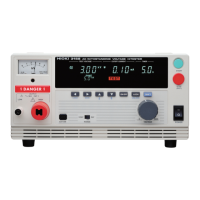38
────────────────────────────────────────────────────
3.5 PASS or FAIL Determination
────────────────────────────────────────────────────
3.5.1 "PASS" State
WARNING
Even when a test has been terminated, there may still be voltage in
the output-voltage terminal when the DANGER lamp is lit. Before
touching the output-voltage terminal, test lead, or tested object, make
sure the analog voltmeter is at 0 kV, the DANGER lamp is OFF, and
the TEST lamp is OFF.
・
The PASS state is held using the PASS Hold function.
Refer to Section "4.1 PASS Hold Function".
Out
ut volta
e
Time
Flashin
Testin
time when it set u
Comparative
volta
evalue
NOTE
3.5 PASS or FAIL Determination
When the preset test time has elapsed, the unit switches to the PASS state and
immediately stops outputting a voltage. If the test time has not been set, PASS
screening is not performed. To the test, press the
STOP
key, which will forcibly
terminate the test.
■
Flow of PASS determination
(1) Press the
START
key to start a test.
(2) If a comparative-voltage value has been set, TEST flickers until the output
voltage switches to the comparative-voltage range. When the output voltage
switches to that range, TEST remains lit and the reduction timer begins
counting down the test time.
(3) A voltage is output until the test time elapses. (If the measured-current value deviates
from the upper- and lower-level values, the unit switches to the FAIL state.
(4) When the preset test time has elapsed, the unit stops outputting a voltage and
switches to the PASS state. PASS lights up in the PASS state.
If a comparative-voltage has not been set, TEST does not flicker.
If the optional "Voltage Comparator Position" function is set to "1: End of test
time", TEST does not flicker.

